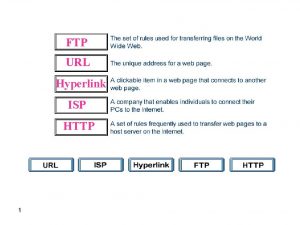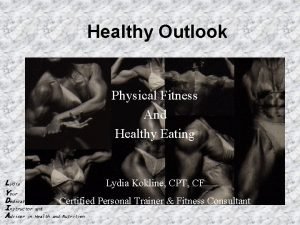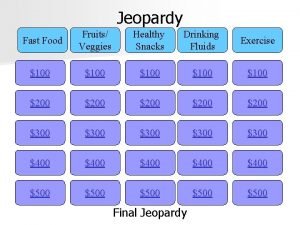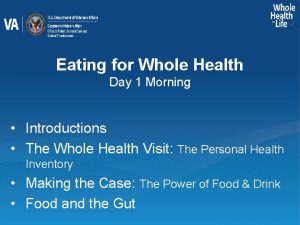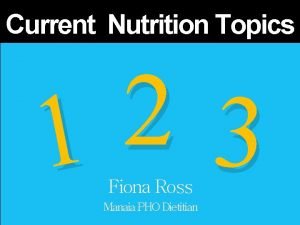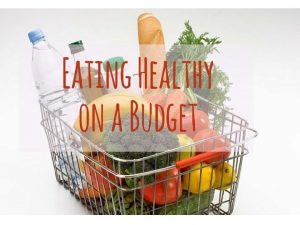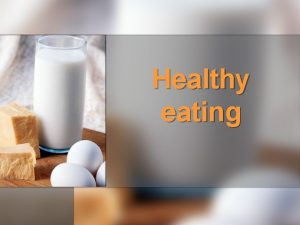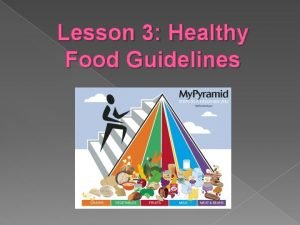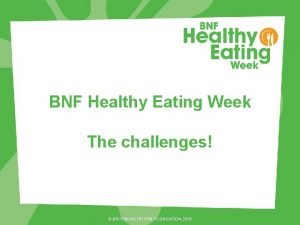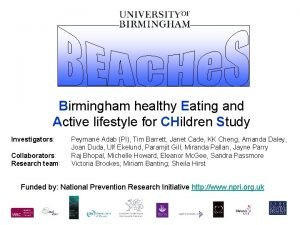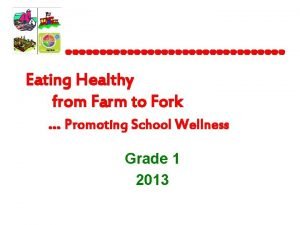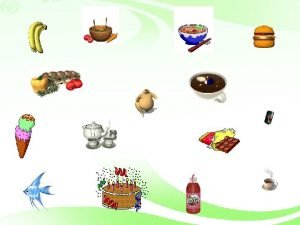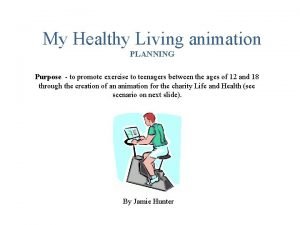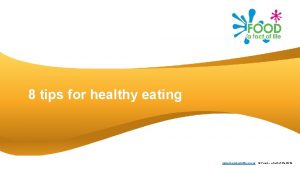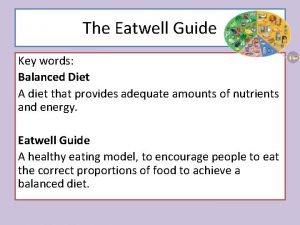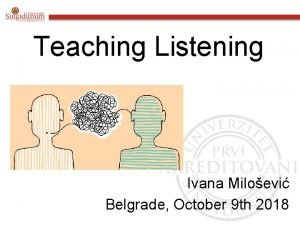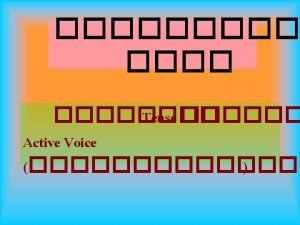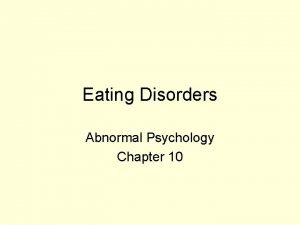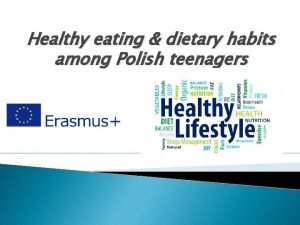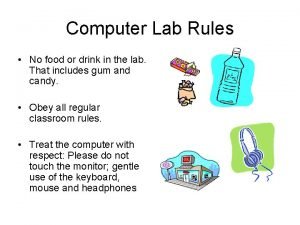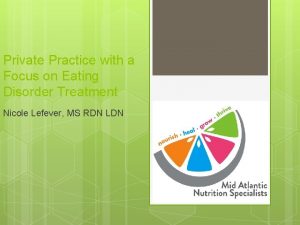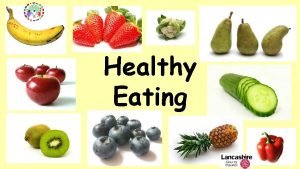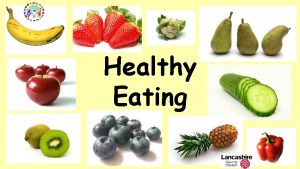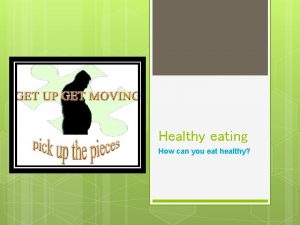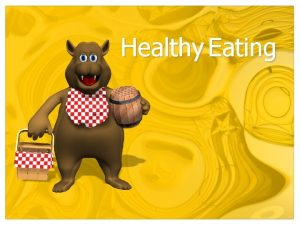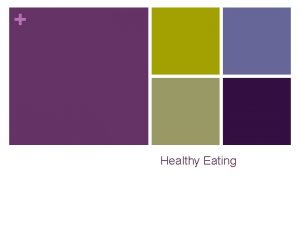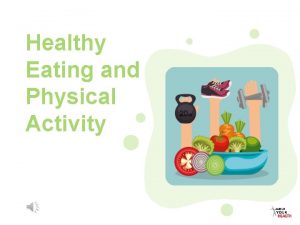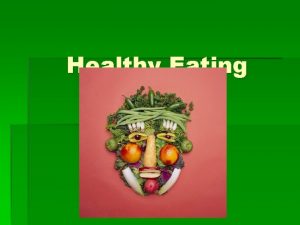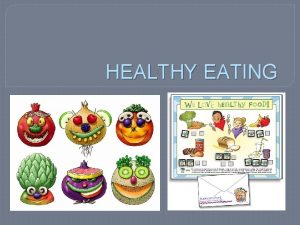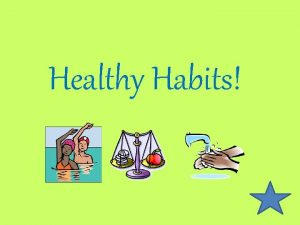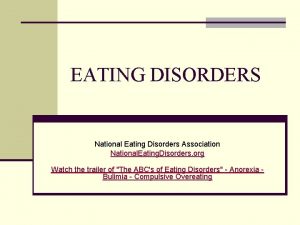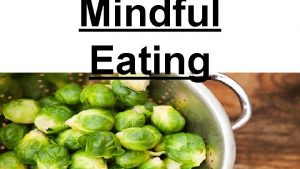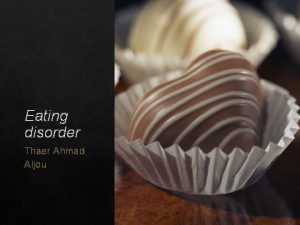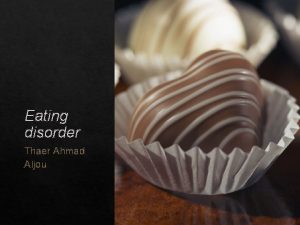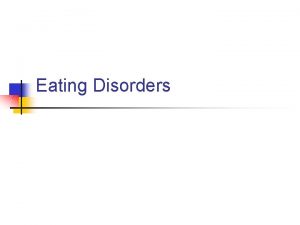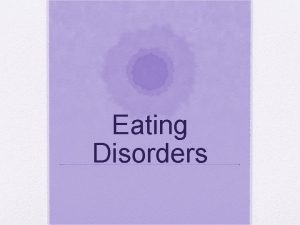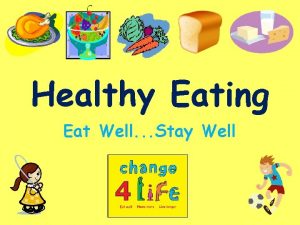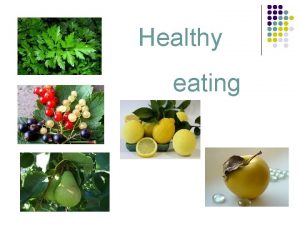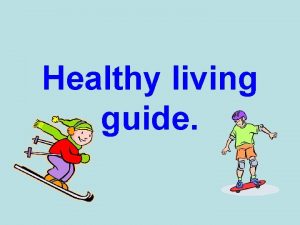Healthy Eating We are what we eat Selina











































- Slides: 43

Healthy Eating We are what we eat Selina Hu, RD

Welcome If you are a kitchen utensil, what do you want to be and why?

Evolution of Food and Nutrition 1700 400 B. C. “Let thy food be thy medicine and thy medicine be thy food. ” - Hippocrates Foods were used to affect health in Greece, as well as across pre-modern Europe and Asia. Healing through food The concept of metabolism was discovered by Antoine Lavoisier 1900 s Diseases were associated with certain diets and discovery of vitamins WW I &WW II Dietetics as a profession was given a boost when its importance was recognized by the military. Scientific development of nutrition

Milestones 1839 Dietetics as a branch of medicine Late 1800 s Dietitians first worked in hospitals 1917 American Dietetic Association established 1940 s Recommended Dietary Allowances (RDAs) in U. S. 1960 s Emergence of enteral nutrition (tube feeds) and parenteral nutrition (IV nutrition)

U. S. China 1917 American Dietetic Association 1945 Chinese Nutrition Society 1963 Recommended Dietary Allowance (RDA) 1997 Chinese Dietary Guideline 2015 first RD examination 1941 RDA 1969 National profession registration and first RD examination 1980 American dietary guidelines

Role of Nutrition in Acute Illness

What does dietitians do? Malnutrition prevalence in the hospital (acute) setting has been widely documented in the literature to be between 20% and 50%. Treat malnutrition

The main cause is the patient’s illness itself (disease-related malnutrition), which can interfere with adequate absorption and metabolism of food via a variety of mechanisms, such as infection-dependent changes in metabolism, loss of appetite, absorption or digestion disorders, disease-specific catabolism, etc. However, there also many other major causes, such as poor dental health, poorly-fitting false teeth, social isolation, gastrointestinal symptoms, addictions, poverty/lack of money, mental illness (e. g. depression, dementia), swallowing disorders, changes in taste perception, complex medication, or an individual’s inability to purchase or prepare food.

Why nutrition? What does dietitians do?

Treat malnutrition ü Nutrition education ü Nutrition supplements ü Enteral nutrition (tube feeds) ü Parenteral nutrition (IV nutrition)





Diabetes Nutrition plays a role in a variety of diseases and conditions Obesity Heart disease/Heart failure Kidney disease/dialysis Liver disease/cirrhosis Cancer GI problems, GI surgeries Wound healing Organ transplant HIV/AIDS Stroke Mechanical ventilation

Role of Nutrition in Chronic Disease

Chronic disease Genetics Predispose a person to a certain disease Internal factor is the gun Environment & Triggers or accelerate the disease to develop External factor pulls the trigger

Food Nutrition Alcohol Smoking ? ? ? … Environment Physical Activity Stress Toxins Pollution



Protein Group All foods made from meat, poultry, seafood, beans and peas, eggs, processed soy products, nuts, and seeds.

Components of Healthy Diet






Dietary Fats and Cardiovascular Disease

Atherosclerosis

Developmental Process Blood clots can travel and block the blood flow to a specific part of the body and trigger heart attack, stroke etc.


LDL cholesterol is the leading cause of atherosclerosis, a strong independent predictor of coronary heart disease. HDL – “good” cholesterol, scavenger, carry picks up excess cholesterol in the blood and takes it back to liver where it is broken down and removed from the body LDL – “bad” cholesterol, carry cholesterol from the liver to body’s cells, contributes to fatty buildups in arteries.

Figure 5. Effects of dietary fat and carbohydrates on blood lowdensity lipoprotein (LDL) cholesterol, triglycerides, and highdensity lipoprotein (HDL) cholesterol (mg/d. L) in metaregression analysis. 1% change in calories. Trans fat: ↑LDL, ↓HDL, ↑ TG Saturated fat: ↑LDL, ↑HDL Polyunsaturated fat: ↓LDL, ↓HDL, ↓TG Monounsaturated fat: ↓LDL, ↓HDL, ↓TG Carbohydrates: ↓LDL, ↓HDL, ↑ TG Frank M. Sacks. Circulation. Dietary Fats and Cardiovascular Disease: A Presidential Advisory From the American Heart Association, Volume: 136, Issue: 3, Pages: e 1 -e 23, DOI: (10. 1161/CIR. 0000000510) © 2017 American Heart Association, Inc.

FIGURE 5 Meta-analysis examining the effect of dietary cholesterol on the LDL to HDL ratio. Net change indicates. . . The American Journal of Clinical Nutrition, Volume 102, Issue 2, August 2015, Pages 276– 294, https: //doi. org/10. 3945/ajcn. 114. 100305 The content of this slide may be subject to copyright: please see the slide notes for details.

How to lower LDL, TG and increase HDL? • Avoid fast food and fried food • Bakery? • Eat less red meat and lean meat only • Remove chicken skins or use chicken breast • Eat more fish, 2 times/week, especially fatty fish such as salmon • Replace animal fat such as lard with plant based oil such as olive oil • Reduce dairy fat, replace full fat milk with fat free, 1% or 2% milk • Reduce refined carbohydrates such as sugar

Heart healthy behaviors • Stop smoking • Quit alcohol ü Limit to one drink per day for women and two drinks per day for men ü One drink = 12 oz beer, 5 oz wine, 1. 5 oz distilled spirits • Increase exercise or physical activity üAt least 150 minutes of moderate intensity physical activity per week üAt least 75 minutes of vigorous exercise per week • Lose weight if overweight or obese

Sodium and Blood Pressure

FIGURE 1 SR versus SBP effect in the upper 25 th BP percentile of the population. Univariable analysis: each circle. . . The American Journal of Clinical Nutrition, Volume 109, Issue 5, May 2019, Pages 1273– 1278, https: //doi. org/10. 1093/ajcn/nqy 384 The content of this slide may be subject to copyright: please see the slide notes for details.

FIGURE 2 SR versus DBP effect in the lower 75 th BP percentile of the population. Univariable analysis: each circle. . . The American Journal of Clinical Nutrition, Volume 109, Issue 5, May 2019, Pages 1273– 1278, https: //doi. org/10. 1093/ajcn/nqy 384 The content of this slide may be subject to copyright: please see the slide notes for details.

Salt Sensitivity • About 60% of people with high blood pressure and are thought to be salt-sensitive • A quarter of people with normal blood pressure people are saltsensitive, although they may develop high blood pressure later • Salt sensitivity increases with age and weight gain • And about 4% to 5% of people have what's known as reverse salt sensitivity, which means their blood pressure actually gets lower when they eat salt.

Fiber • Prevent and relieve constipation • Increase satiety and help maintain healthy weight • Delay absorption/digestion and lower blood sugar and risk for diabetes • Decrease cholesterol levels and lower risk for heart disease

Sugar ∙ Fat ∙ Sodium ∙ Fiber

More resources • Ketogenic diet https: //www. health. harvard. edu/blog/ketogenic-diet-is-the-ultimate-low-carb-diet-good-for-you 2017072712089 • Meal planning https: //www. choosemyplate. gov/ • Dietary guidelines https: //health. gov/dietaryguidelines/2015/ • Podcast https: //peterattiamd. com/podcast/
 Mikael ferm
Mikael ferm Etf prevent
Etf prevent Selina stewart
Selina stewart Projekt voda
Projekt voda Priska schär
Priska schär We are what we eat
We are what we eat Unsent messages selina
Unsent messages selina The healthy eating project lydia
The healthy eating project lydia Myplate jeopardy
Myplate jeopardy How eating healthy affects your body
How eating healthy affects your body Healthy eating title
Healthy eating title The three p's for eating healthy on a budget
The three p's for eating healthy on a budget Healthy eating questionnaire for schools
Healthy eating questionnaire for schools Healthy eating sentences
Healthy eating sentences Interactive guide to healthy eating and active living
Interactive guide to healthy eating and active living When is healthy eating week 2018
When is healthy eating week 2018 Healthy eating birmingham
Healthy eating birmingham Healthy eating | esol nexus (britishcouncil.org)
Healthy eating | esol nexus (britishcouncil.org) Eating healthy from farm to fork
Eating healthy from farm to fork Energy giving food definition
Energy giving food definition Healthy living animation
Healthy living animation British council esol nexus
British council esol nexus Foodfactoflife
Foodfactoflife Healthy eating key words
Healthy eating key words People buy me to eat
People buy me to eat I would rather eat potatoes than to eat rice yay or nay
I would rather eat potatoes than to eat rice yay or nay They eat or eats
They eat or eats Healthy forests healthy communities poster contest
Healthy forests healthy communities poster contest Healthy food healthy mind journal
Healthy food healthy mind journal Healthy nurse healthy nation
Healthy nurse healthy nation Healthy soil healthy life poster ideas
Healthy soil healthy life poster ideas Kate moss anorexia
Kate moss anorexia Family eating at table
Family eating at table Eating or drinking verbs that express anger
Eating or drinking verbs that express anger Managing weight and eating behaviors
Managing weight and eating behaviors Polish food pyramid
Polish food pyramid Gnhq merchants
Gnhq merchants Mantis eating nipples
Mantis eating nipples Elephant eating habits
Elephant eating habits Are cheetahs carnivores or omnivores
Are cheetahs carnivores or omnivores Klee eating fish
Klee eating fish Albert einstein eating a banana
Albert einstein eating a banana No food or drink near computers
No food or drink near computers Fear food list
Fear food list






